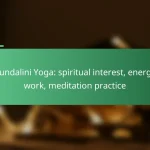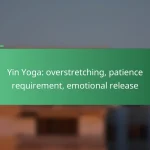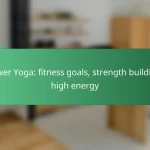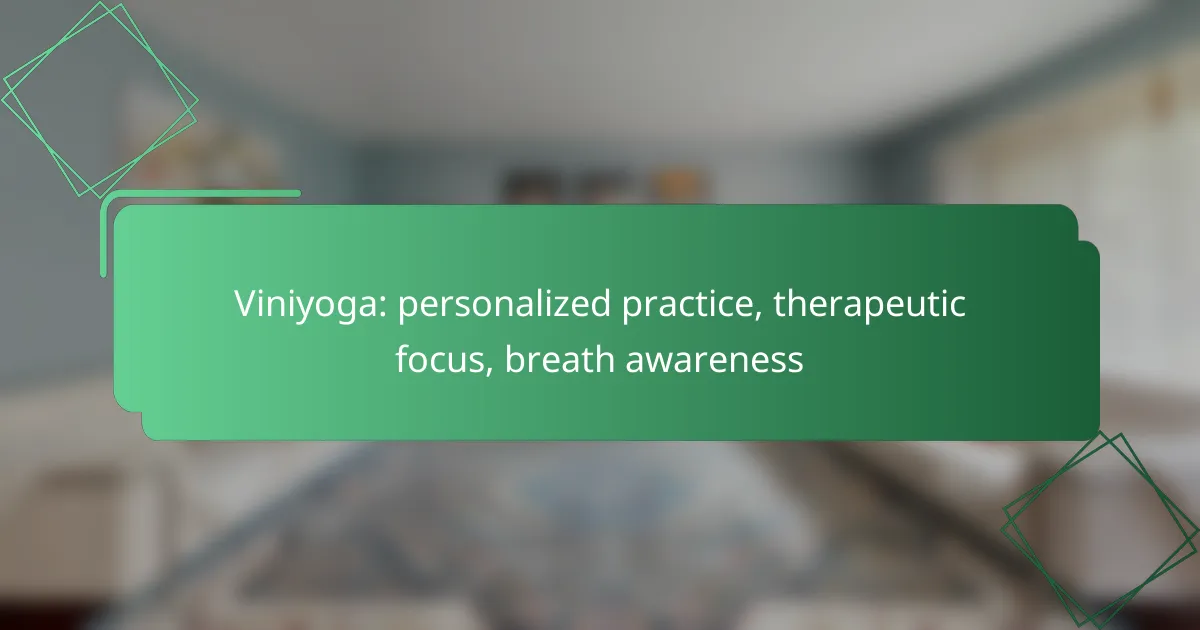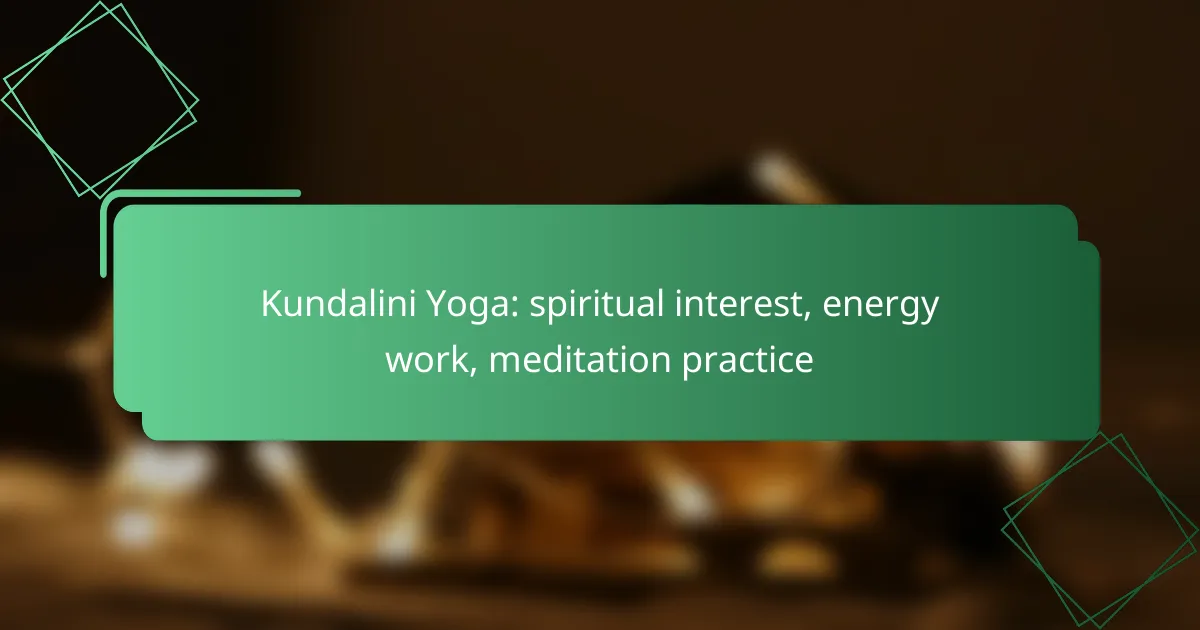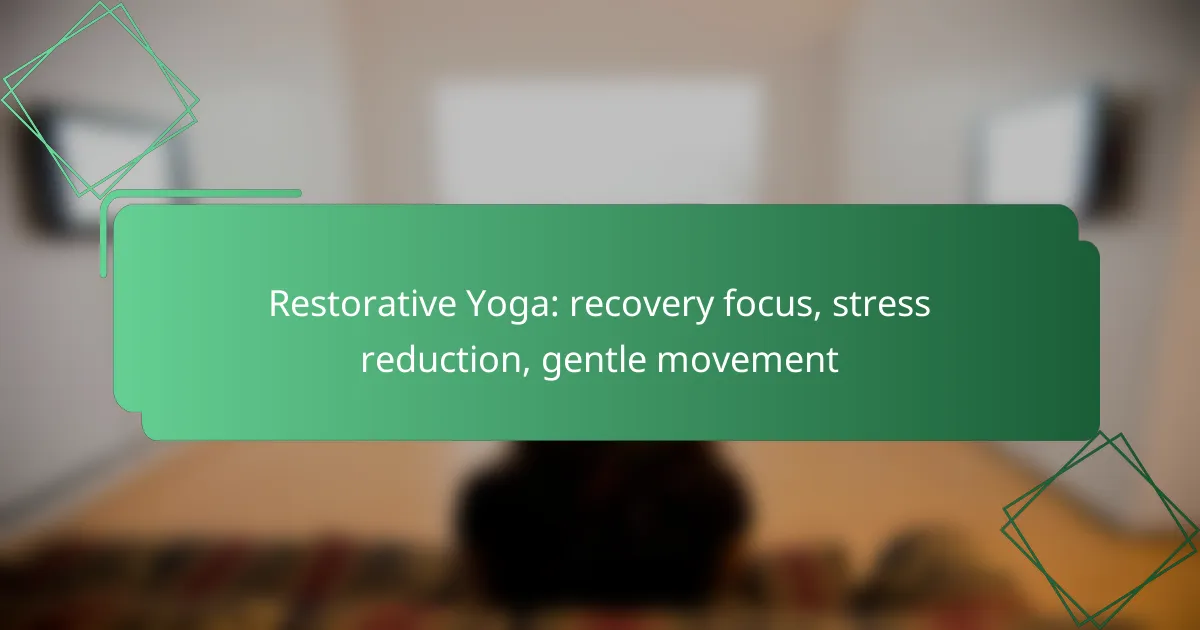Viniyoga is a personalized approach to yoga that tailors sequences to meet individual needs, ensuring a unique experience for each practitioner. With a strong emphasis on breath awareness, this method not only enhances physical capabilities but also promotes therapeutic benefits such as stress relief and improved mental clarity.

How does Viniyoga promote personalized practice?
Viniyoga promotes personalized practice by tailoring yoga sequences to individual needs, ensuring that each practitioner receives a unique experience that aligns with their personal goals and physical capabilities. This approach emphasizes adaptability and breath awareness, making it suitable for a wide range of students.
Individualized sequences
In Viniyoga, individualized sequences are designed based on the practitioner’s specific requirements, abilities, and preferences. This means that no two sequences are alike; they can vary in intensity, duration, and focus areas, allowing for a more effective practice. For example, a beginner may focus on foundational postures, while an advanced practitioner might explore more complex asanas.
Adaptation to student needs
Adaptation is a core principle of Viniyoga, where instructors assess each student’s physical condition, limitations, and goals. This might involve modifying poses or suggesting alternative movements to ensure safety and effectiveness. For instance, if a student has a knee injury, the instructor may provide variations that alleviate strain while still promoting strength and flexibility.
Focus on personal goals
Viniyoga encourages practitioners to set personal goals that guide their practice. Whether the aim is to improve flexibility, reduce stress, or enhance overall well-being, the sequences are crafted to support these objectives. Regular check-ins with instructors can help students adjust their goals and practices as they progress, ensuring continuous growth and motivation.

What therapeutic benefits does Viniyoga offer?
Viniyoga provides various therapeutic benefits, focusing on personalized practices that enhance physical and mental well-being. Its emphasis on breath awareness and tailored techniques makes it effective for stress relief, pain management, and improving mental clarity.
Stress reduction techniques
Viniyoga incorporates specific breathing exercises and gentle movements designed to lower stress levels. Techniques such as slow, deep breathing and mindful stretching can activate the body’s relaxation response, helping to reduce anxiety and promote a sense of calm.
Practitioners can benefit from establishing a daily routine that includes these stress reduction techniques. Even short sessions of 10-15 minutes can significantly impact overall stress levels, making it easier to manage daily challenges.
Pain management strategies
Viniyoga offers targeted approaches to alleviate chronic pain through tailored postures and breath control. By focusing on areas of tension, practitioners can learn to release physical discomfort and improve mobility.
Incorporating gentle, restorative poses can help manage pain effectively. It’s advisable to consult with a qualified instructor who can customize a practice based on individual needs, ensuring safety and effectiveness.
Enhanced mental clarity
Viniyoga promotes enhanced mental clarity through practices that combine breath awareness with mindful movement. This holistic approach helps clear the mind, allowing for improved focus and cognitive function.
Regular practice can lead to better concentration and decision-making skills. Setting aside time for Viniyoga, even just a few times a week, can foster a clearer mindset and greater emotional resilience.
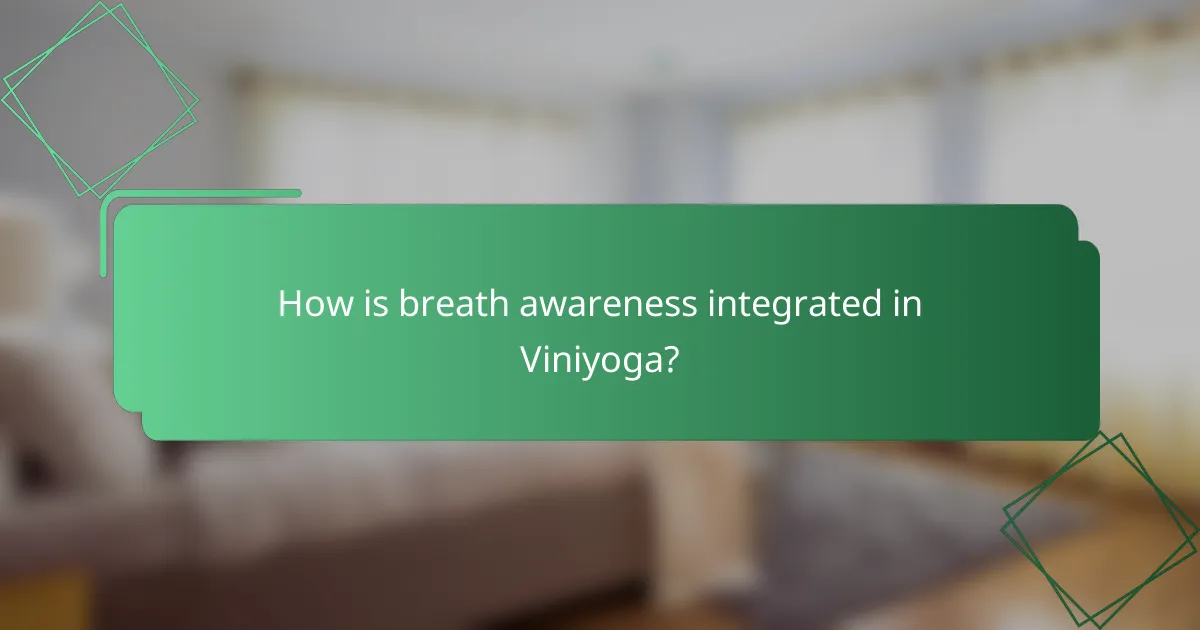
How is breath awareness integrated in Viniyoga?
Breath awareness in Viniyoga is a fundamental aspect that enhances the practice’s therapeutic focus. It involves consciously observing and controlling the breath to promote relaxation, concentration, and overall well-being.
Pranayama practices
Pranayama, or breath control, is central to Viniyoga and includes various techniques designed to regulate the breath. Common practices include Ujjayi, Nadi Shodhana, and Kapalabhati, each serving different purposes such as energizing, calming, or detoxifying the body. Practicing pranayama regularly can help improve lung capacity and reduce stress levels.
When incorporating pranayama into your routine, start with short sessions of 5 to 10 minutes, gradually increasing the duration as you become more comfortable. Focus on the quality of your breath rather than the quantity to ensure effective practice.
Breath synchronization with movement
In Viniyoga, breath synchronization with movement is essential for creating a fluid and mindful practice. Each movement is typically paired with an inhalation or exhalation, enhancing the connection between body and mind. For example, inhaling while extending the arms and exhaling while folding forward helps maintain rhythm and focus.
To effectively synchronize breath with movement, practice simple sequences such as Sun Salutations. Pay attention to your breath, allowing it to guide your movements, which fosters a deeper awareness of your body’s capabilities and limitations.
Mindfulness through breath
Mindfulness through breath in Viniyoga encourages practitioners to cultivate present-moment awareness. By focusing on the breath, individuals can quiet the mind and enhance their ability to observe thoughts and feelings without judgment. This practice can lead to improved emotional regulation and mental clarity.
To develop mindfulness through breath, try dedicating a few minutes at the beginning or end of your practice to simply observe your breath. Notice its natural rhythm, sensations, and any thoughts that arise, allowing them to pass without attachment. This practice can be a powerful tool for stress reduction and self-discovery.
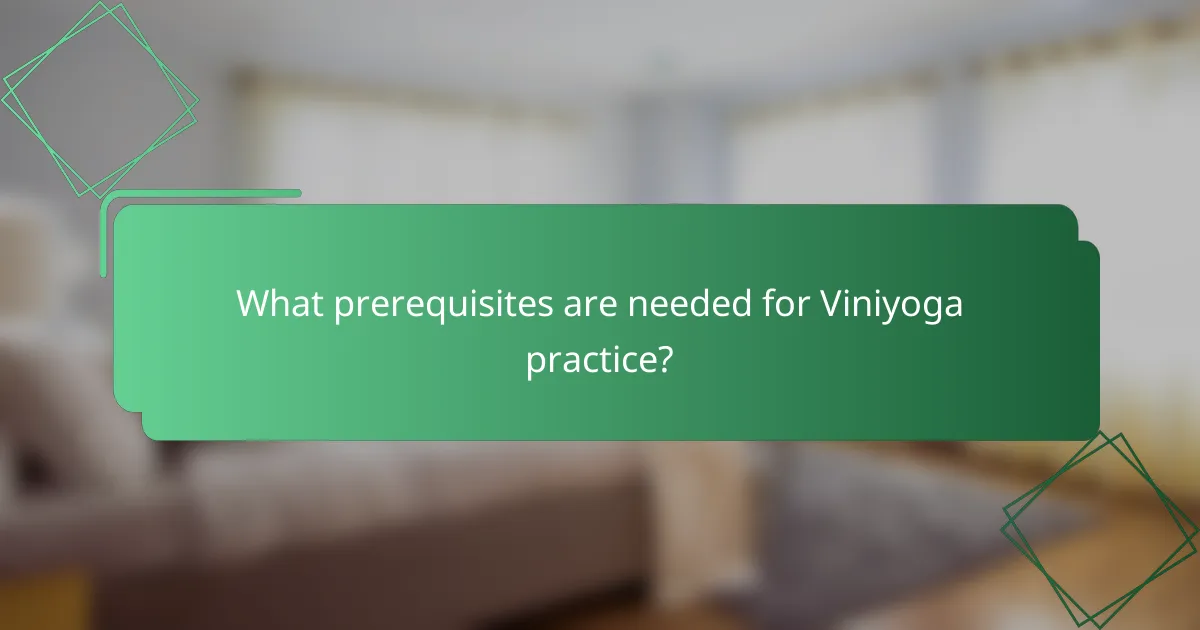
What prerequisites are needed for Viniyoga practice?
To engage in Viniyoga practice effectively, a foundational understanding of basic yoga principles and breath techniques is essential. These prerequisites help practitioners tailor their sessions to individual needs and enhance therapeutic benefits.
Basic yoga knowledge
A solid grasp of basic yoga concepts is crucial for Viniyoga. This includes familiarity with common postures (asanas), alignment principles, and the overall philosophy of yoga. Understanding these elements allows practitioners to adapt poses to their unique physical conditions and goals.
Beginner practitioners should consider taking introductory yoga classes or workshops to build this foundational knowledge. Resources such as books, online courses, or local classes can also provide valuable insights into yoga’s core principles.
Understanding of breath techniques
Breath awareness is a cornerstone of Viniyoga, making it vital to understand various breath techniques (pranayama). These techniques help regulate energy flow and enhance relaxation, which is essential for therapeutic practices. Familiarity with basic breath patterns, such as diaphragmatic breathing and Ujjayi breath, is beneficial.
Practitioners should practice breath techniques regularly, as this will improve their ability to integrate breath with movement during Viniyoga sessions. Simple exercises, like inhaling for a count of four and exhaling for a count of six, can help develop this skill effectively.

How to choose a Viniyoga instructor?
Choosing a Viniyoga instructor involves assessing their qualifications, experience, and teaching style to ensure a personalized and therapeutic practice. Look for instructors who can tailor sessions to your specific needs and have a strong focus on breath awareness.
Qualifications and certifications
When selecting a Viniyoga instructor, check their qualifications and certifications. Ideally, they should have completed a recognized training program in Viniyoga, which often includes a minimum of 200 hours of study.
Certifications from reputable organizations, such as the Viniyoga Institute or Yoga Alliance, can indicate a solid foundation in yoga principles and teaching methodologies. Additionally, ongoing education in related fields can enhance their expertise.
Experience with therapeutic applications
Experience with therapeutic applications is crucial for a Viniyoga instructor, as this practice often addresses specific health concerns. Instructors should have a background in adapting yoga techniques for various conditions, such as chronic pain, anxiety, or rehabilitation.
Ask potential instructors about their experience with therapeutic settings and any success stories from previous clients. This insight can help you gauge their ability to support your individual health goals.
Personal teaching style
A personal teaching style can greatly influence your Viniyoga experience. Consider whether you prefer a more structured approach or a flexible, intuitive style that adapts to your needs during each session.
During an introductory session, pay attention to how the instructor communicates and guides you through practices. A good fit will foster a comfortable environment that encourages breath awareness and personal growth.
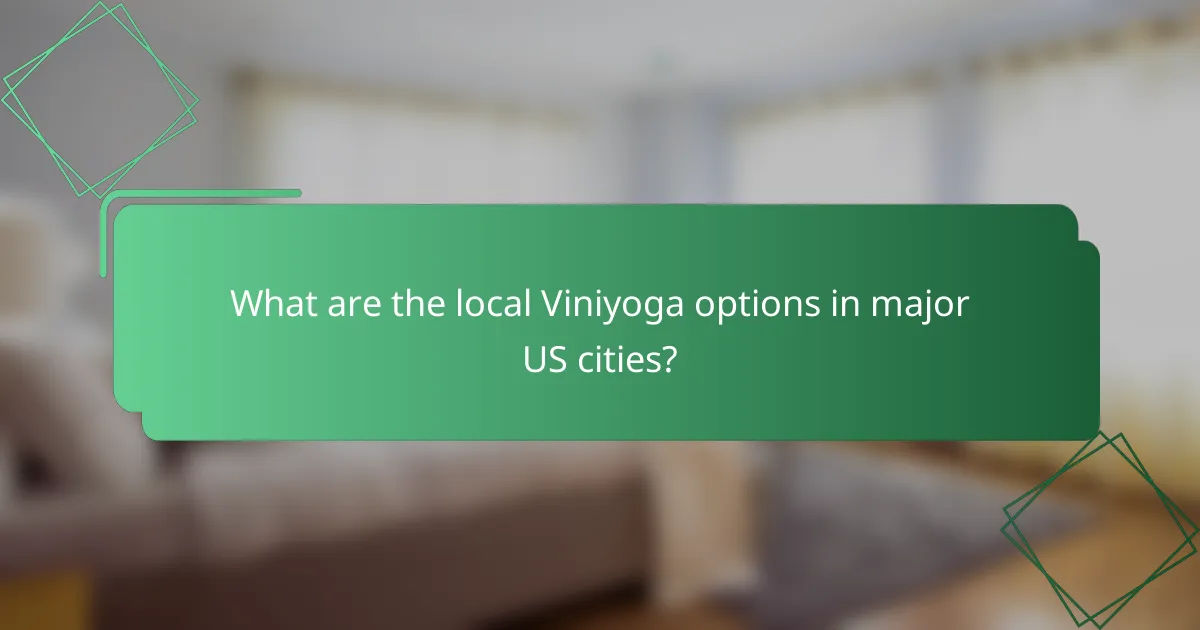
What are the local Viniyoga options in major US cities?
In major US cities, Viniyoga offers a variety of personalized practices, therapeutic classes, and workshops that focus on breath awareness. These options cater to different skill levels and therapeutic needs, making it accessible for anyone interested in enhancing their yoga experience.
Viniyoga studios in New York
New York City hosts several dedicated Viniyoga studios, each offering a range of classes tailored to individual needs. Notable studios include the Viniyoga Institute and the Yoga Room, where instructors focus on adapting practices to suit personal health conditions and goals.
Classes typically range from beginner to advanced levels, with a strong emphasis on breath work and therapeutic techniques. Many studios also provide private sessions for a more personalized approach.
Classes available in Los Angeles
Los Angeles features numerous Viniyoga classes that emphasize breath awareness and therapeutic benefits. Popular locations such as YogaWorks and the Viniyoga Center offer various class formats, including group sessions and one-on-one instruction.
Classes often integrate elements of mindfulness and alignment, allowing participants to explore their practice at their own pace. Pricing for classes generally falls within the $20 to $30 range per session, with packages available for frequent attendees.
Workshops in Chicago
Chicago offers a selection of Viniyoga workshops designed to deepen understanding and practice. Studios like the Chicago Yoga Center frequently host workshops that focus on specific themes, such as breath control or therapeutic applications for common ailments.
These workshops typically last a few hours to a full day and provide an immersive experience. Participants can expect to engage in both practice and discussion, enhancing their overall yoga journey. Registration fees vary but usually range from $50 to $100, depending on the length and content of the workshop.

